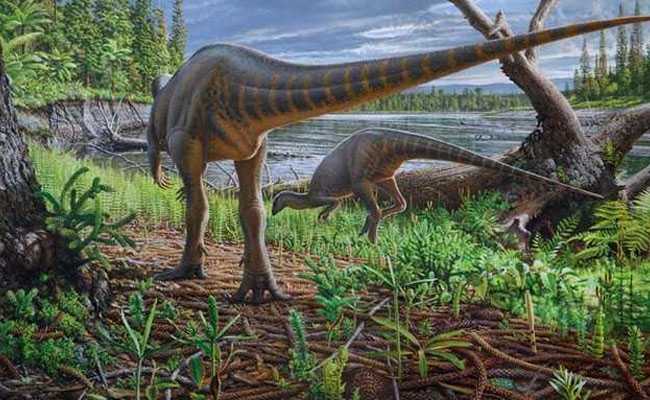Dinosaur footprints found on the cliffs of Folkestone, Kent. (vice)
–
London:
The footprints of at least six different types of dinosaurs — the last dinosaurs to walk on British soil 110 million years ago — have been found in Kent, according to a new report from researchers.
The discovery of dinosaur footprints by the curators of the Hastings Museum and Art Gallery and scientists from the University of Portsmouth is the last dinosaur record in the UK.
Footprints have been found on cliffs and by the beach in Folkestone, Kent, where stormy conditions affect cliffs and coastal waters, constantly revealing new fossils.
Professor David Martell from the University of Portsmouth said: “This is the first time dinosaur footprints have been found in the layer known as the ‘Folkestone Formation’ which is an unusual find as these dinosaurs were the last to roam this country before it went extinct. Portsmouth Paleontology.
“They’ve sailed close to where the White Cliffs are in Dover now – the next time you’re on the ferry and you see that amazing Cliff, imagine that,” he said.
The findings were published in the Proceedings of the Geologists ‘Association’ this week, and some of the footprints are on display at the Folkestone Museum.
Fossil footprints formed from sediment fill in the impressions left by dinosaur feet as they hit the ground, preserving them afterward.
Footprints of various dinosaurs, showing the relatively large diversity of dinosaurs in southern England at the end of the Early Cretaceous period, 110 million years ago.
They are believed to be ankylosaurs, armored dinosaurs that looked roughly resembling living tanks; theropods, which were three-toed meat-eating dinosaurs such as Tyrannosaurus rex; and ornithopods, plant-eating dinosaurs with “hips” due to their somewhat bird-like pelvic structure.
Philip Hadland, Curator of Collections and Engagement, at the Hastings Museum and Art Gallery is the lead author of this paper.
“In 2011, I discovered an unusual impression in the Folkestone rock formation. They seem to repeat themselves and all I can think of is that they might be footprints,” Hadland said.
“This goes against what most geologists say about the rocks here, but I looked for more footprints, and when the tide showed more erosion I found better ones. More work is needed to convince the scientific community that this is true, so I teamed up with Experts at the University of Portsmouth to examine what I found.”
Most of the finds are isolated footprints, but one find is made up of six footprints – making a “track”, which is more than successive footprints of the same animal.
These prints are similar in size to elephant footprints and have been identified as possibly Ornithopodichnus, which is similar, but smaller footprints have been found in China from the same time period.
The largest footprint found – 80 cm wide and 65 cm long – was identified as belonging to an iguanodon-like dinosaur.
Iguanodont are also plant eaters, growing up to 10 meters and walking with two or four feet.
(This story has not been edited by the NDTV crew and was created automatically from a shared feed.)
–


:quality(80)/cdn-kiosk-api.telegraaf.nl/31c036e4-d10c-11eb-bfc1-0218eaf05005.jpg)